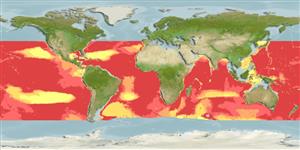>
Stomiiformes (Lightfishes and dragonfishes) >
Sternoptychidae (Marine hatchetfishes) > Sternoptychinae
Etymology: Argyropelecus: Greek, argyros = silvered, silver + Greek, pelekys = axe (Ref. 45335).
More on author: Norman.
Environment: milieu / climate zone / depth range / distribution range
Ökologie
seewasser bathypelagisch; tiefenbereich 300 - 1000 m (Ref. 58018), usually 400 - 600 m (Ref. 4054). Deep-water; 72°N - 54°S, 180°W - 180°E
Eastern Atlantic: Portugal to South Africa; northern record from south Iceland (Ref. 4739). Western Atlantic: 40°N-40°S, including the Gulf of Mexico (Ref. 27768). One record from the Patagonian region of Argentina (Ref. 27363). Indian Ocean: 0°- 40°S. Eastern Pacific: 15°S-40°S. Western Pacific: 20°N-40°S.
Size / Gewicht / Alter
Maturity: Lm ? range ? - ? cm
Max length : 12.0 cm SL Männchen/unbestimmt; (Ref. 4462)
Rückenflossenstacheln (insgesamt): 0; Rückenflossenweichstrahlen (insgesamt): 9-10; Afterflossenstacheln 0; Afterflossenweichstrahlen: 12 - 13. Dorsal blade present and well developed in front of dorsal fin (Ref. 27363). Deep body (Ref. 37473).
An oceanic and mesopelagic species (Ref. 4739). No indication of diel migration (Ref. 4739). Adult complement of photophores acquired at about 1.4 cm SL (Ref. 4739).
Life cycle and mating behavior
Geschlechtsreife | Fortpflanzung | Ablaichen | Eier | Fecundity | Larven
Quéro, J.-C., J.C. Njock and M.M. de la Hoz, 1990. Sternoptychidae. p. 275-282. In J.C. Quero, J.C. Hureau, C. Karrer, A. Post and L. Saldanha (eds.) Check-list of the fishes of the eastern tropical Atlantic (CLOFETA). JNICT, Lisbon; SEI, Paris; and UNESCO, Paris. Vol. 1. (Ref. 4462)
IUCN Rote Liste Status (Ref. 130435)
Bedrohung für Menschen
Harmless
Nutzung durch Menschen
Fischereien: nicht kommerziell
Mehr Information
NamenSynonymeMetabolismusRäuberÖkotoxikologieFortpflanzungGeschlechtsreifeAblaichenSpawning aggregationFecundityEierEientwicklung
ReferenzenAquakulturAquakultur ProfilZuchtlinienGenetikElectrophoresesVererbbarkeitKrankheitenVerarbeitungNutrientsMass conversion
Tools
Zusatzinformationen
Download XML
Internet Quellen
Estimates based on models
Preferred temperature (Ref.
123201): 5.9 - 11.5, mean 8.6 °C (based on 573 cells).
Phylogenetic diversity index (Ref.
82804): PD
50 = 0.5078 [Uniqueness, from 0.5 = low to 2.0 = high].
Bayesian length-weight: a=0.01905 (0.01050 - 0.03457), b=3.04 (2.88 - 3.20), in cm total length, based on LWR estimates for this species & Genus-body shape (Ref.
93245).
Trophic level (Ref.
69278): 3.1 ±0.2 se; based on size and trophs of closest relatives
Widerstandsfähigkeit (Ref.
120179): mittel, Verdopplung der Population dauert 1,4 - 4,4 Jahre. (Preliminary K or Fecundity.).
Fishing Vulnerability (Ref.
59153): Low vulnerability (10 of 100).
